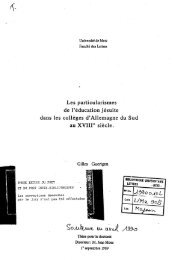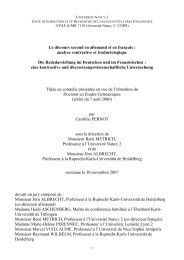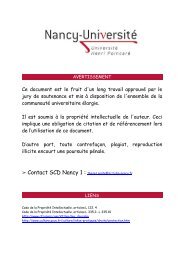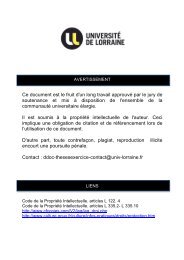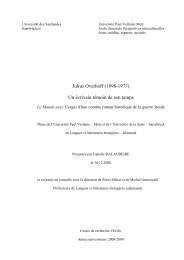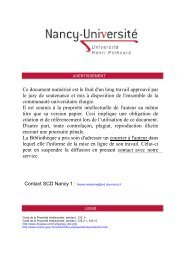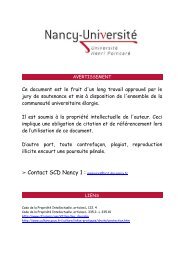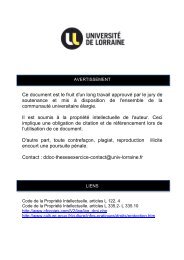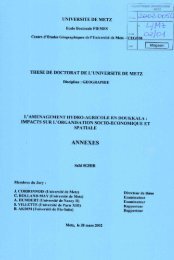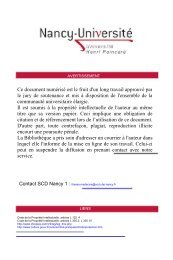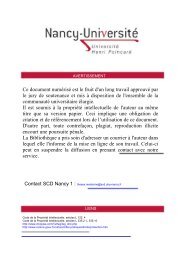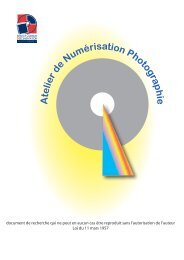- Page 1 and 2:
AVERTISSEMENT Ce document est le fr
- Page 4 and 5:
Remercîments Ce travail a été fi
- Page 6 and 7:
tes petites bébêtes toutes gentil
- Page 10 and 11:
Tables des matières Introduction .
- Page 12 and 13:
C. Minéralisations dans les pegmat
- Page 14:
B. Etudes isotopiques .............
- Page 17 and 18:
16 Le Paléoprotérozoïque défini
- Page 19 and 20:
séculaire des changements de compo
- Page 21 and 22:
Supercontinents. Ces mouvements son
- Page 23 and 24:
22 3. Evolution de l’atmosphère
- Page 25 and 26:
24 b. Cause de l’évolution du δ
- Page 27 and 28:
26 4. Evolution du climat et de la
- Page 29:
28 5.2. Sédimentation post-GOE Le
- Page 33 and 34:
32 1.2.1. Granites métalumineux (i
- Page 35 and 36:
1999a) où l’uranium est corrél
- Page 37 and 38:
36 2. Minéralisation en U en relat
- Page 39 and 40:
38 La plupart des gisements, et sur
- Page 42 and 43:
Figure 6: Reconstruction du Superco
- Page 44 and 45:
Le district de Cage localisé au No
- Page 46 and 47:
ctÜà|x ctÜà|x ctÜà|x DM Z°É
- Page 48 and 49:
Trans-Hudson qui définit l’ensem
- Page 50 and 51:
3. Histoire tectonique régionale L
- Page 52 and 53:
Cage Figure I-4 : Chronologie des
- Page 54 and 55:
4. Métamorphisme associé à l’o
- Page 56 and 57:
1.2.1. Corrélation du GLH a. Group
- Page 58 and 59:
2. Géologie structurale Cartograph
- Page 60 and 61:
Mrb dolomitique Mrb calcitique pur
- Page 62 and 63:
3.2. Etude géologique d’Areva Un
- Page 64 and 65:
Le marbre dolomitique forme des ban
- Page 66 and 67:
C A Davis Inlet Or Pegmatite Mc Qtz
- Page 68 and 69:
(i) Un premier groupe (skarnoïde A
- Page 70 and 71:
Figure I-10 : Diagramme ternaire pr
- Page 72 and 73:
0,03) sont corrélées aux teneurs
- Page 74 and 75:
(i) Lorsque l’olivine est présen
- Page 76 and 77:
E A CA-07-7A C Di Ol Dol Figure I-1
- Page 78 and 79:
Figure I-15 : Séquence paragénét
- Page 80 and 81:
E A Cal C Phl CA-07-6F CA-07-26A Ca
- Page 82 and 83:
3.3.4. Les skarnoïdes A a. Pétrog
- Page 84 and 85:
3.3.5. Les skarnoïdes B a. Pétrog
- Page 86 and 87:
A C C Marbre Ctc Skarnoïde A Di Sk
- Page 88 and 89:
Figure I-21 : Séquence paragénét
- Page 90 and 91:
de l’apatite. Les méta-cinérite
- Page 92 and 93:
3.3.8. Méta-quartzites a. Pétrogr
- Page 94 and 95:
3.4. Géochimie des isotopes stable
- Page 96 and 97:
N° échantillon % Cal % Dol % Carb
- Page 98 and 99:
δf - δi = 1000 (F (α-1) - 1) δf
- Page 100 and 101:
Figure I-28 : Diagramme δ 18 OCarb
- Page 102 and 103:
e. Interaction avec du graphite Pen
- Page 104 and 105:
conclusions: 3.4.4. Conclusions Les
- Page 106 and 107:
Figure I-30 : Diagramme SiO2 en fon
- Page 108 and 109:
3.5.2. Evaporites dans le groupe de
- Page 110 and 111:
Scapolite « sédimentaire » CA-07
- Page 112 and 113:
c. Le Bore dans le groupe de Lake H
- Page 114 and 115:
e. Le Fluor dans le groupe de Lake
- Page 116 and 117:
4. Conclusions Deux grands ensemble
- Page 118 and 119:
D. Analyse structurale La S1 bouge
- Page 120 and 121:
Figure I-39 : Carte détaillée du
- Page 122 and 123:
(i) la transposition de S1 par une
- Page 124 and 125:
Figure I-43 : Coupe interprétative
- Page 126 and 127:
cartographique ainsi nommé (antifo
- Page 128 and 129:
A Cage Est B Cage Est C CA-07-10A A
- Page 130 and 131:
les terres rares lourdes (Ho et Er)
- Page 132 and 133:
4,00 3,00 2,00 1,00 0,00 Effectif (
- Page 134 and 135:
2.1.3. Géochimie a. Majeurs Ces pe
- Page 136 and 137:
c. ETR Les spectres ETR (Figure I-5
- Page 138 and 139:
206 Pb/ 238 U 0,50 0,40 0,30 0,20 0
- Page 140 and 141:
2.2. Granite A’ - pegmatite A’
- Page 142 and 143:
E A C Zrn Bt Qtz Bt Ur Bt Figure I-
- Page 144 and 145:
Les pegmatites riches en schlierens
- Page 146 and 147:
2.2.5. Conclusion Ces roches provie
- Page 148 and 149:
E A C Marbre Peg B Tr Aln Qtz Peg B
- Page 150 and 151:
aux autres pegmatites. Cette pegmat
- Page 152 and 153:
3.5. Conclusions Les pegmatites B
- Page 154 and 155:
4.3.3. ETR Les spectres ETR de ces
- Page 156:
(i) raccourcissement N 80-100 et ci
- Page 159:
Figure I- 65 : Skarnoïde amphiboli
- Page 162 and 163:
5.2.2. Pegmatite D D’un point de
- Page 164 and 165:
5.3. Géochimie 5.3.1. Pegmatite C
- Page 166 and 167:
. Traces (Annexes) Les pegmatites D
- Page 168 and 169:
Q=Si/3-(K+Na+2Ca/3) 400 350 300 250
- Page 170 and 171:
Leucosomes Peg A Granite A’ Peg A
- Page 172 and 173:
Figure I- 74 : Relation granite A
- Page 174 and 175:
2. Skarn secondaire (sk 2) Une sér
- Page 176 and 177:
Figure I- 77 : Veines d’actinolit
- Page 178 and 179:
3. Endoskarn 2 La scapolitisation e
- Page 180 and 181:
2.4. Conclusion La localisation des
- Page 182 and 183:
G. Minéraux produits au cours du m
- Page 184 and 185:
Figure I-81 : Diagramme de classifi
- Page 186 and 187:
Figure I-82 : Diagramme de classifi
- Page 188 and 189:
2.4. Les phlogopites Les phlogopite
- Page 190 and 191:
ctÜà|x ctÜà|x E `|Ç°ÜtÄ|át
- Page 192 and 193:
Ces zones anomales n’ont pas d’
- Page 194 and 195:
1.3. Minéralisations dans les pegm
- Page 196:
Indice Indice Nanuk Bocamp Indice Y
- Page 201 and 202:
E A C Ol Figure II- 7: A. Echantill
- Page 203 and 204:
202 2.1. Métaux systématiquement
- Page 205 and 206:
E A C Figure II- 10: A. BSE Barytin
- Page 207 and 208:
Figure II- 11: Diagramme de classif
- Page 209 and 210:
208 2.1.3. Les minéraux à molybd
- Page 211 and 212:
A C Figure II- 14: A. BSE Associati
- Page 213 and 214:
sphalérite marquent la foliation d
- Page 215 and 216:
Figure II- 16: A. BSE Billes de mat
- Page 217 and 218:
Figure II- 17 : Diagramme U (ppm) e
- Page 219 and 220:
218 3.2. Eléments traces Un échan
- Page 221 and 222:
Figure II- 20 : Diagramme Mg/Ca (ca
- Page 223 and 224:
Figure II- 22 : Diagramme Mg/Ca (ca
- Page 225 and 226:
Figure II- 24 : Diagramme Mg/Ca (ca
- Page 227 and 228:
Figure II- 26: Diagramme Mg/Ca (cat
- Page 229 and 230:
Figure II- 28 : Diagramme Pb (ppm)
- Page 231 and 232:
Figure II- 30 : Diagramme Ba, Zn, M
- Page 233 and 234:
Figure II- 31 : Diagramme Th, Zr, N
- Page 235 and 236:
Figure II- 32 : Diagramme ETR (ppm)
- Page 237 and 238:
236 c. Spectre des roches minérali
- Page 239 and 240:
C. Minéralisations dans les pegmat
- Page 241 and 242:
autour des uraninites. Ces uraninit
- Page 243 and 244:
A C Figure II- 40 : A. LR. Uranotho
- Page 245 and 246:
244 1. Minéralisation dans les enc
- Page 247 and 248:
246 2. Minéralisations associées
- Page 249 and 250:
A C Figure II- 43 : A. Indice 7% Pe
- Page 251 and 252:
A C Figure II- 44 : A. CA-07-2B Fil
- Page 253 and 254:
A C Figure II- 45 : A. CA-07-33B Ve
- Page 255 and 256:
Figure II- 46 : A. CA-08-9A Pegmati
- Page 257 and 258:
Figure II- 47 : Diagramme isocon d
- Page 259 and 260:
258 5.2.2. Marbre à U-Th Le marbre
- Page 261 and 262:
260 6. Comportement des ETR 6.1. Mi
- Page 263 and 264:
262 6.3. Minéralisations des skarn
- Page 265 and 266:
E. Conclusion 264 Deux grands types
- Page 267 and 268:
A. Introduction 266 Les deux types
- Page 269 and 270:
confirmé des études au MET (Fayek
- Page 271 and 272:
an) et 222 Rn (T=3.824 j) tend à l
- Page 273 and 274:
272 4. Rappels sur les datations is
- Page 275 and 276:
particulièrement marqué pour les
- Page 277 and 278:
276 Le spectre de l’uraninite du
- Page 279 and 280:
206 Pb/ 238 U 206 Pb/ 238 U Figure
- Page 281 and 282:
Les teneurs en ThO2 sont relativeme
- Page 283 and 284:
Figure III- 7 : Diagramme ternaire
- Page 285 and 286:
284 1.4. Skarn 1 proche des pegmati
- Page 287 and 288:
Figure III- 11 : Diagramme ternaire
- Page 289 and 290:
288 3. Datation U/Pb des oxydes d
- Page 291 and 292:
206 Pb/ 238 U 206 Pb/ 238 U 206 Pb/
- Page 293 and 294:
Figure III- 15 : Récapitulatif des
- Page 295 and 296:
il a été suggéré que ce granite
- Page 297 and 298:
températures. Ce dernier phénomè
- Page 299 and 300:
Figure III- 16: Valeurs en 87 Sr/ 8
- Page 301 and 302:
(iii) une source pour les Gneiss de
- Page 303 and 304:
87 Sr/ 86 Sri des skarns primaires
- Page 305 and 306:
N° Sm Nd ( échantillon (ppm) (ppm
- Page 307 and 308:
306 Les spectres ETR obtenus sont s
- Page 309 and 310:
A. Le groupe du Lake Harbour 308 Le
- Page 311 and 312:
ôle des pegmatites B dans leur gen
- Page 313 and 314:
1977). De plus, les complexes carbo
- Page 315 and 316:
postérieurement métamorphisés (p
- Page 317 and 318:
316 2.3. Conséquences pour l’U 2
- Page 319 and 320:
318 Les deux types de séquence son
- Page 321 and 322:
C. Les minéralisations dans les sk
- Page 323 and 324:
liquides/fluides produits dans la c
- Page 325 and 326:
324 3.1. Les skarns à U-Th de Tran
- Page 327 and 328:
A. Le cycle de l’uranium Paléopr
- Page 329 and 330:
la Wollaston et de Taltson Belt et
- Page 331 and 332:
330
- Page 333 and 334:
Abraham, K., et al. (1972). "On the
- Page 335 and 336:
Brooks, J. H. (1960). "Uranium depo
- Page 337 and 338:
Dodson, R. G., et al. (1974). "Uran
- Page 339 and 340:
Hocquet, S. (2007). "Cage - Cartogr
- Page 341 and 342:
Lauri, L., et al. (2007). "Source c
- Page 343 and 344:
Moine, B., et al. (1981). "Geochemi
- Page 345 and 346:
Ruhlmann, F., et al. (1986). "Un ex
- Page 347 and 348:
Tallarico, F. H. B., et al. (2005).
- Page 349 and 350:
348
- Page 351 and 352:
Introduction Figure 1: A. Evolution
- Page 353 and 354:
352 (Gln). E. LPA Cristaux de scapo
- Page 355 and 356:
Figure I-47 : Datation U/Pb sur zir
- Page 357 and 358:
Figure I-79 : A. Pegmatite A à fel
- Page 359 and 360: Figure II- 16: A. BSE Billes de mat
- Page 361 and 362: 360 titanite (Ti) dans une veine à
- Page 363 and 364: Figure Anx- 5 : Compositions en él
- Page 365 and 366: Introduction Tableau 1: Caractéris
- Page 367 and 368: A. Etudes pétrographiques des éch
- Page 369 and 370: 368 4. Spectroscopie d’émission
- Page 371 and 372: Marbre pur calcitique Marbre impur
- Page 373 and 374: Marbre pur dolomitique Marbre pur d
- Page 375 and 376: 374 Marbre impur dolomitique (i) Ma
- Page 377 and 378: 376 Skarnoïde A CA-07-25A CA-07-39
- Page 379 and 380: 378 Skarnoïde B CA-07-27A CA-07-5B
- Page 381 and 382: 380 Paragneiss Méta- Quartzite Mé
- Page 383 and 384: 382 Endoskarn CA-07-1A CA-07- CA-07
- Page 385 and 386: 384 CA-07- 2A CA- 07- 31A Skn CA- 0
- Page 387 and 388: 386 GASC Minéralisé à U-Th CA-08
- Page 389 and 390: 388 Pegmatite A' CA-07-30B CA-07-34
- Page 391 and 392: 390 Pegmatite B Pegmatite B' CA-07-
- Page 393 and 394: 392 Pegmatite C Pegmatite D CA-08-
- Page 395 and 396: 394 2.1. La ligne des silicates La
- Page 397 and 398: 396 3. Les isotopes radiogéniques
- Page 399 and 400: (3) ( 143 Nd/ 144 Nd)CHUR;t = 0,512
- Page 401 and 402: échantillon Pb ppm U ppm Th ppm 40
- Page 403 and 404: 402 4.2. Localisations des points d
- Page 405 and 406: 404
- Page 407 and 408: 406 5. Datations U/Pb et spectre ET



